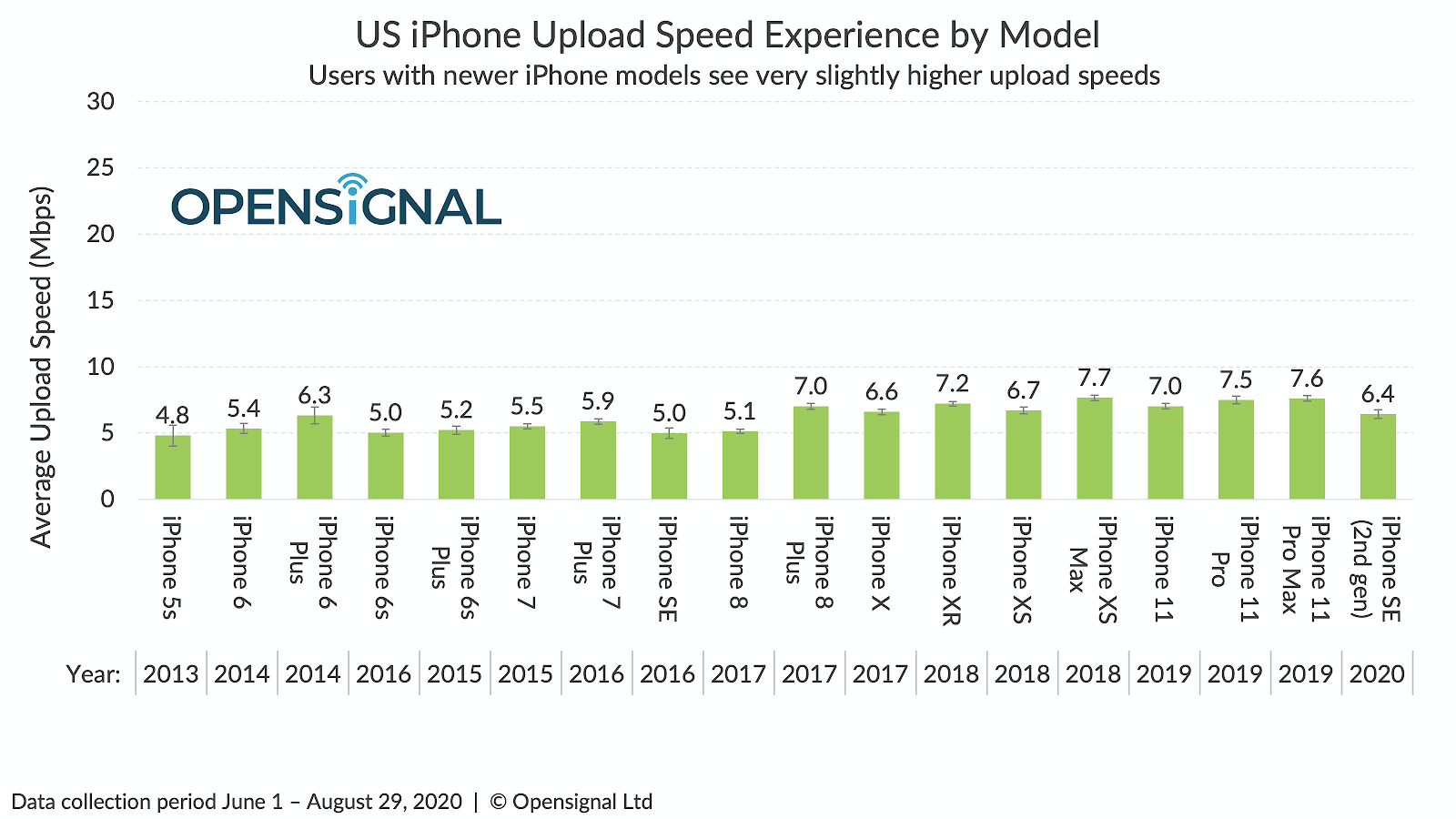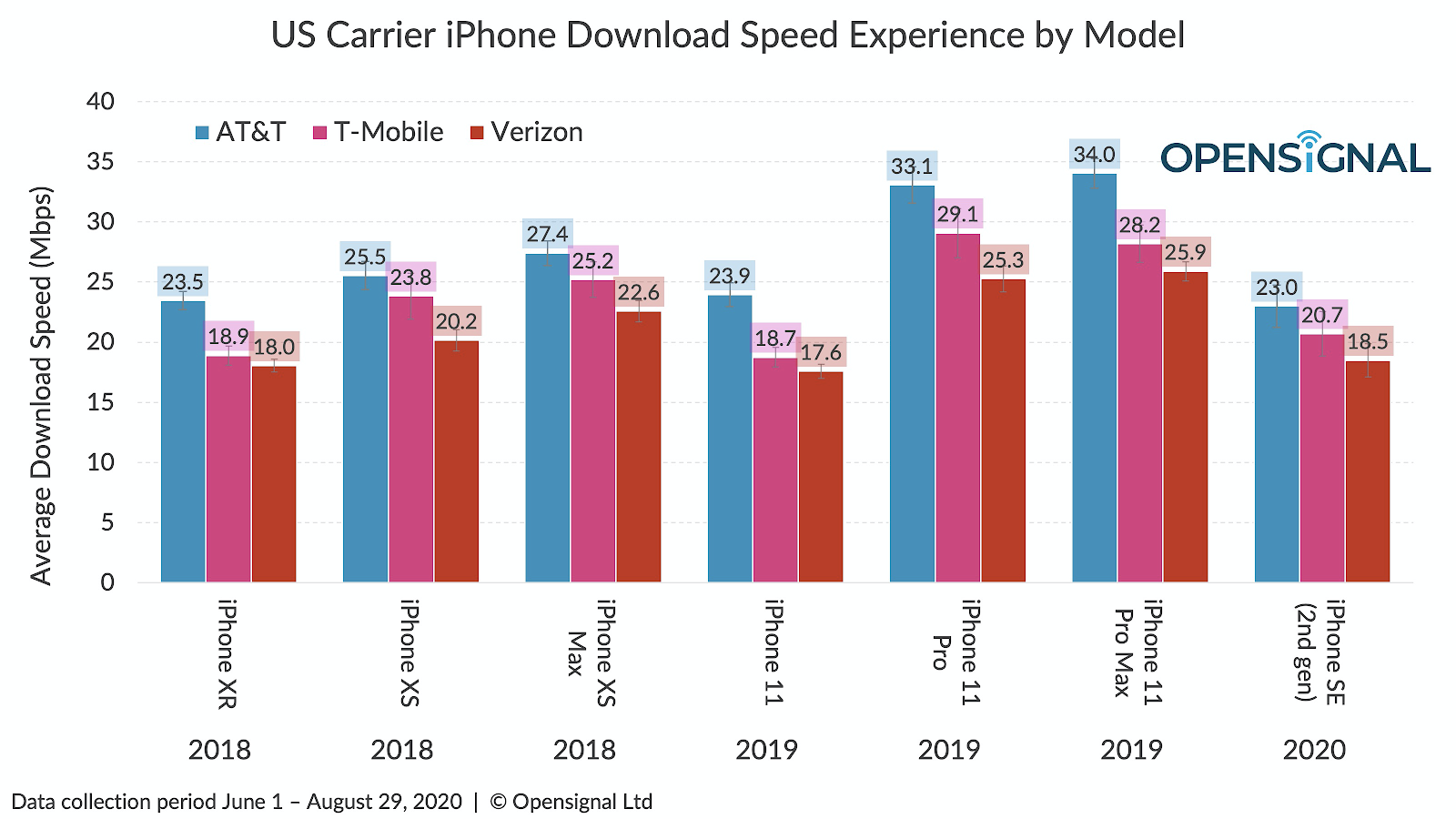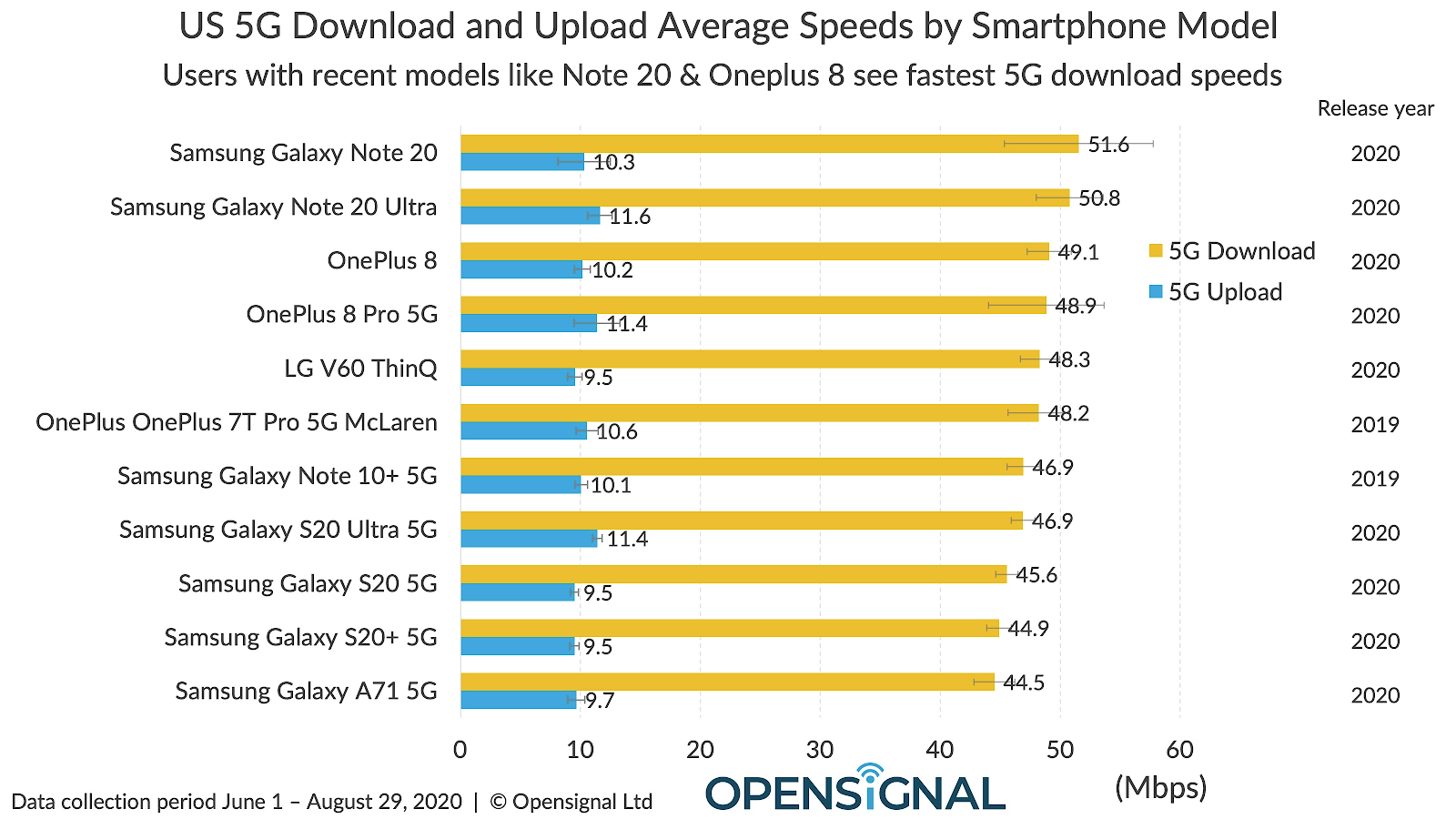Quantifying the 5G smartphone experience & what it means for upcoming 5G iPhones
Key takeaways
The fastest 5G smartphone brand and the maker of the fastest 5G model differ. While U.S. OnePlus users experience the fastest average 5G download speeds of 56 Mbps ahead of LG and Samsung’s users, it is owners of Samsung’s Galaxy Note 20 that have the fastest 5G download speeds of any smartphone model in the U.S. with 51.6 Mbps.
Apple iPhone users are set for a big speed jump with 5G. If Apple’s 5G launch follows the trend of existing 5G brands then 2020’s 5G iPhone owners will see a bigger generational leap in mobile network experience than the iPhone has had for at least eight years when 2012’s iPhone 5 marked the jump from 3G to 4G. Users on current 5G brands have seen 5G average download speeds between 1.6 and 1.9 times faster than 4G in the U.S.
The arrival of 5G iPhones should boost overall U.S. mobile speeds. About half of smartphone users in the U.S. own the iPhone, but have not been able to enjoy the superior 5G experience to date because all iPhones have been 4G-only. With 5G, iPhone users will see faster speeds raising the overall U.S. experience.
iPhone users’ experience varies across U.S. carriers. Owners of the seven iPhone models released between 2018 and mid 2020 have the fastest average download speeds on AT&T, but the fastest upload speeds on T-Mobile. However, that is based on recent iPhone models which are all 4G, the 5G market and experience is very different.
Oldest iPhone model owners have the slowest experience and are top upgrade targets. Users with iPhone models released between 2013 and 2016 have the most to gain with the arrival of 5G. Today, they experience download speeds ranging from 7.8 and 9 Mbps, which is much slower than either iPhone 11 Pro owners’ 29 Mbps or those with 5G models from other brands.
Smartphone design increasingly matters for the mobile network experience. The newest iPhone model does not guarantee the fastest speeds. Owners of recent models like iPhone 11 and iPhone SE lag the speeds seen by owners of the iPhone 11 Pro range because these models have similar design and speeds to older phones like the iPhone XR and iPhone 8 respectively although they have newer modems. 5G and especially mmWave increases the antenna design challenges for smartphone makers.
Apple and Google are the last two major U.S. smartphone brands to launch 5G models and both are unveiling 5G smartphones in autumn 2020. A new iPhone always drives enormous activity in the U.S. as carriers lead with the latest Apple smartphones in their marketing and consumers gauge whether it’s time to upgrade their phone.
The first 5G iPhones will reignite the race to 5G because iPhone shipments consistently represent almost half of total smartphone shipments in the U.S. Lack of 5G iPhone models has held back U.S. 5G adoption. Now, those that prefer to use the iPhone will now have the option of upgrading to 5G without having to switch away from a familiar brand, apps and user experience.
For the first time, Opensignal examines the experience of 5G across leading smartphone brands and models. We analyze how real-world 5G compares with 4G and we assess how the experience of different iPhone models compares with 5G smartphones in the U.S.

Comparing three leading 5G smartphone makers, OnePlus 5G users experience average 5G download speeds of 56.0 Mbps compared with 53.7 Mbps for LG and 50.5 Mbps for Samsung. All three brands’ users see much slower 4G download speeds.
Until Apple and Google launch first 5G smartphones in autumn 2020 their mobile network user experience is only directly comparable on 4G speeds: Google users’ 4G download speeds are similar to the 4G download speeds of OnePlus; LG and Samsung and Apple iPhone users see slightly slower average speeds.
The lift which 5G brings highlights the importance of the upcoming 5G iPhone launch to Americans and to U.S. carriers. If we see a similar leap in experience by adding 5G capability to the iPhone then this will raise the average mobile network experience of the U.S. significantly because almost half of Americans use the iPhone according to Counterpoint.
If Apple’s 5G launch follows the trend of existing 5G smartphone handset brands, with a speed increase of 5G of 1.6 - 1.9 times faster than 4G, then 2020’s 5G iPhone owners will see a bigger generational leap in mobile network experience than the iPhone has had for at least eight years when 2012’s iPhone 5 marked the jump from 3G to 4G.

In previous iPhone generations, the type of 4G LTE modem indicated the typical speeds a user owning that model would experience. Those with a model and modem capable of a higher LTE category saw faster speeds.
This trend appears to have broken down now, because some 2019 and 2020 models buck the trend. But the type of iPhone model owned still affects the network experience, just in different ways:
iPhone design now matters for network experience, not just age or modem type. The latest SE has an industrial design similar to the iPhone 8 and its owners have approximately the same speed, yet the 2020 SE has a newer modem. The same trend applies for the iPhone 11 which has a similar design to the older iPhone XR but a newer modem. In 2020, Apple will move to a new industrial design for the iPhone 12 making it especially interesting to see if this trend continues.
Owning the latest iPhone model is no guarantee of seeing the fastest speeds. While users with an iPhone 11 Pro or Pro Max experience speeds over 29 Mbps, those with the standard iPhone 11 — also released in 2019 — only see speeds of 19.4 Mbps. While those using 2020’s second generation iPhone SE have speeds of 19.9 Mbps. These two models differ in their industrial design and radio antennas from the 11 Pro and XS ranges.
Users with iPhone models older than three years do see much slower speeds. Significantly, the iPhone users who have likely had their phone for three years or more, and so are likely out of contract and ready to upgrade, do have much slower speeds. Average download speeds for models released in 2017 are just under 20 Mbps or 31% slower than users of 11 Pro models. Those with models four years of older see even slower speeds ranging between 7.8 Mbps and 15.9 Mbps.
Apple is expected to switch industrial design and launch four new iPhone models for the first time in 2020, including a small 5.4” display model. Supporting mmWave 5G requires special antennas, and it will be interesting to see how Apple accommodates them in the 5G iPhones and what impact design will have on the 5G network experience. Opensignal will be analyzing the mobile user experience on the new 5G iPhones to see how each model compares.
The Apple iPhone experience may jump by a greater multiplier than other brands in the shift to 5G because while other brands tend to use the same modem supplier for both their 4G and 5G smartphones in the U.S., Apple is making a switch in modem supplier as well as mobile network generation. In recent years, Apple has used Intel modems for all iPhone models, but is expected to shift to Qualcomm this year because of a new agreement for Qualcomm to supply chips to Apple.

While there are significant differences in the average download speeds owners of different iPhone models see, there is little variation in upload speeds. Owners with newer iPhones typically have average upload speeds about 1 Mbps faster than those with older models.
In time, the shift to 5G will boost mobile upload speeds. But carriers need to deploy newer versions of 5G technology before most 5G users will benefit from faster upload speeds.

Across recent iPhone models from the last two years, iPhone users on AT&T experience faster average download speeds than owners using T-Mobile or Verizon. The difference between the U.S. carriers varies by iPhone model. For the latest iPhone SE, just 4.5 Mbps separates the experience on each carrier, while for the iPhone 11 Pro Max the difference is 8.1 Mbps and 7.8 Mbps for the users with the iPhone 11 Pro model.
But all of these differences are based on 4G technology, because no current iPhone yet supports 5G. 2020’s new 5G iPhones will connect to the network on each carrier in a different way.
New 5G iPhone users will have to carefully assess how carriers compare on 5G and which best fits their needs. Notably, the picture is very different on 5G to the overall U.S. mobile network experience.
The U.S. 5G market is very dynamic, for example with the merger of Sprint and T-Mobile’s 5G networks, new 5G spectrum auctions which will boost 5G capacity, the launch of standalone access (SA) 5G, and moves to use dynamic spectrum sharing (DSS) by AT&T and soon Verizon. Opensignal continues to track 5G developments and the impact on the real-world 5G experience.

Comparing iPhone users’ upload speeds reveals a different picture. T-Mobile iPhone users on all recent models have faster speeds than do iPhone owners on AT&T or Verizon. The actual upload speeds differ little between models and in most cases are a statistical tie. But again, remember, all of these iPhone models are using 4G technology and the experience will change when 5G models launch.

Users with all of the top 5G smartphone models enjoy average 5G download speeds very significantly faster than average speeds of current iPhone users, indicating the potential impact that adding 5G to the iPhone will have on Apple users. The 5G download speed enjoyed by Samsung Note 20 users ranges from 6.6 to 1.5 times faster than the average download speed of users with different iPhone models.
New 2020 models like the OnePlus 8 and 8 Pro, or the just released (August) Samsung Galaxy Note 20 range, top Opensignal’s comparison of 5G download speeds in the U.S. by smartphone model. Older 2019 models that rank in the top tier include the Samsung Galaxy S10+ 5G and OnePlus 7T Pro 5G but users have slower average 5G download speeds.
On 5G upload speeds we do not see a great variation in the speeds 5G smartphone model owners experience. Again, this reflects the current early state of the 5G market, and will change over time.
Given 5G phones have only been available for just over a year, it’s impressive to see the industry already iterating to move forward the 5G network experience. With Opensignal’s ongoing focus on quantifying the 5G real-world, we will continue to assess how the U.S. 5G mobile experience evolves with newer 5G smartphone models from Apple, Google and others and with new 5G technologies deployed by the carriers.
Opensignal Limited retains ownership of this insight including all intellectual property rights, data, content, graphs & analysis. Reports and insights produced by Opensignal Limited may not be quoted, reproduced, distributed, published for any commercial purpose (including use in advertisements or other promotional content) without prior written consent. Journalists are encouraged to quote information included in Opensignal reports and insights provided they include clear source attribution. For more information, contact [email protected].
